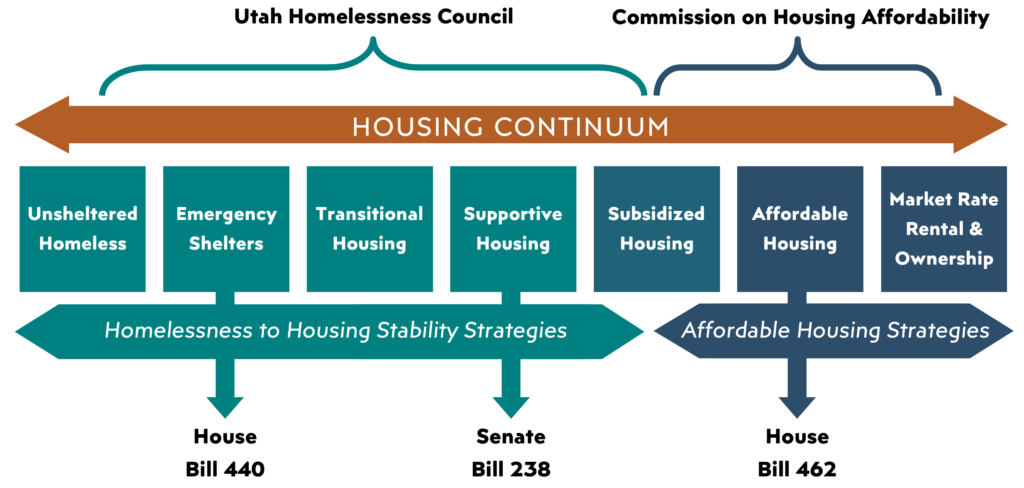Affordable Housing versus Homelessness
Housing can be thought of on a continuum as shown below, divided between strategies for homelessness on the left and strategies for affordable housing for moderate income groups on the right:

According to the U.S. Department of Housing and Urban Development (HUD), housing is considered affordable if the gross monthly cost including utilities is no more than 30% of a household’s gross monthly income. Another important metric in talking about affordable housing is area median income. This is the midpoint of a region’s income distribution, where half of the households earn more than the median, and half earn less. AMI is used to define low-income households, which are classified as follows: low-income (50-80% AMI), very low income (30-50% AMI), and extremely low-income (below 30% AMI). These income levels set in relation to AMI identify households that may be eligible for affordable housing programs that HUD administers. For example, to be eligible for HUD’s Housing Choice Voucher Program, household income must be at or below 50% AMI. The table below shows the area median income for counties in Utah and the salary for each of these low-income groups; the salary shown is the high end of the range.
| County | AMI | 80% AMI (Low Income) | 50% AMI (Very Low Income) | 30% AMI (Extremely Low Income) |
| Cache | $69,800 | $55,800 | $34,900 | $20,940 |
| Davis | $90,900 | $72,700 | $45,500 | $27,300 |
| Iron | $61,900 | $49,500 | $31,000 | $18,600 |
| Salt Lake | $92,900 | $74,300 | $46,500 | $27,900 |
| Summit | $120,800 | $96,600 | $60,400 | $36,200 |
| Utah | $83,700 | $67,000 | $41,900 | $25,000 |
| Wasatch | $95,400 | $76,300 | $47,700 | $28,600 |
| Weber | $90,900 | $72,700 | $45,500 | $27,270 |
| State of Utah | $85,300 | $68,200 | $42,700 | $25,600 |
2022 General Session Investments in Homelessness and Affordable Housing
During the 2021 General Session, policymakers passed House Bill 347, “Homeless Services Amendments”, creating the Office of Homeless Services in the Department of Workforce Services (DWS). Prior to that, homeless services were under the Division of Housing and Community Development within DWS. The legislation also created the State Homelessness Coordinator position in the Governor’s Office of Planning and Budget and established the Utah Homelessness Council. Governor Cox appointed former Senate President Wayne Niederhauser as the State Homelessness Coordinator April of 2021. Among other things, H.B. 347 (2021) required the council and coordinator to create a statewide strategic plan to minimize homelessness, which includes recommendations to improve the state’s services for those experiencing homelessness. The first iteration of that strategic plan under the coordinator and new office will be presented to legislative committees during October 2022 interim meetings.
Using input from both the State Homeless Coordinator and Office of Homeless Services, legislators addressed a number of issues along the housing continuum during the 2022 General Session.
They prioritized and funded the following items related to homelessness:
- $55.0 million one-time from American Rescue Plan federal funds for deeply affordable housing grants and wraparound services (S.B. 238). These funds are for households making less than 30% area median income and will serve those who are experiencing or are at risk of homelessness. The Commission on Housing Affordability supported this recommendation;*
- $5.0 million ongoing from the General Fund for Homeless Shelter Cities Mitigation Restricted Account for cities to mitigate impacts from having a homeless shelter (H.B. 440);*
- $5.8 million one-time from the General Fund to assist in repaying a loan for a homeless shelter (H.B. 440);
- $1.0 million one-time from American Rescue Plan federal funds to provide overflow shelter for individuals experiencing homelessness (H.B. 440);
- $322,200 ongoing from the General Fund for Office of Homeless Services staffing (H.B. 2 Item 79);* and
- $6.0 million one-time from Temporary Assistance for Needy Families federal funds for temporary housing assistance for formerly incarcerated individuals with families (H.B. 2 Item 76).
Legislators also provided funding for the following affordable housing initiatives:
- $1.3 million one-time from the General Fund for affordable and rural workforce housing efforts (H.B. 462. This bill was recommended by the Commission on Housing Affordability);*
- $5.0 million one-time from the General Fund for assistance to law enforcement officers who are first-time home buyers (H.B. 2 Item 195);
- $15.0 million for preservation of affordable housing where deed restrictions are ending (H.B. 2 Item 195); and
- Reallocation of $5.0 million from Redevelopment Matching Grants to USU Monument Valley (H.B. 3 Item 157). This reduced the total set aside for Redevelopment Matching Grants to $30.0 million (2021 First Special Session), and expanded the permissible uses to include water projects.
*Items included in the Governor’s Budget.